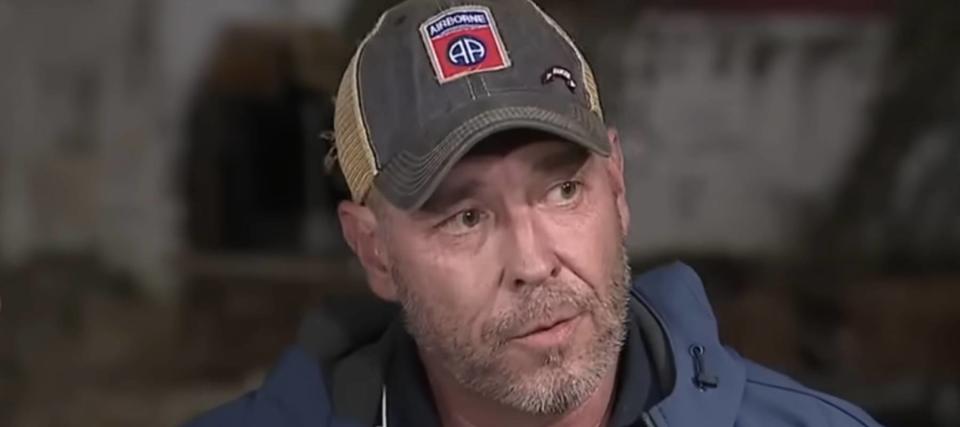N.C. mayor says daughter was denied $750 FEMA aid promised by Kamala Harris after Hurricane Helene ‘wiped out’ her home

Before Hurricane Milton crashed in Florida this week, Hurricane Helene hit the Southeastern U.S. hard, leaving widespread destruction in its wake.
Derek Roberts, the mayor of Newland, North Carolina, experienced the devastation up close.
Don't miss
Here is the true value of having a fully paid-off home in America — especially when you're heading into retirement
'I could've been set for life': This former Goldman Sachs analyst says his family of 4 can't live comfortably on $230K a year after buying 'forever home.' Is the American dream out of reach?
Commercial real estate has beaten the stock market for 25 years — but only the super rich could buy in. Here's how even ordinary investors can become the landlord of Walmart, Whole Foods or Kroger
“It turned ugly quick — it went from some rain and some wind to a tree in our bedroom and our basement was flooding,” he told Fox News.
In response, the Biden-Harris administration launched relief efforts. According to FEMA (Federal Emergency Management Agency), the agency “has already helped thousands of Hurricane Helene survivors jumpstart their recoveries with more than $10 million in flexible, upfront funding.”
Despite these efforts, Roberts was left frustrated by his daughter’s experience with FEMA.
“What is FEMA? I mean, literally what is FEMA?” Roberts said, expressing his frustration. “So my daughter, whose house got completely wiped out, she has no flood insurance, meets with a FEMA person, applies for everything, doesn't get the $750 that Kamala says that she's supposed to get.”
Roberts noted that his daughter eventually received some assistance — $300 for personal items — but questioned how much that would help given the extent of the damage.
“Her entire first floor is wiped out. We hauled everything off. It's gone… They gave her $300, that won't even cover what's in her refrigerator,” he explained.
The ‘myth’ behind the $750 payment
During her visit to Augusta, Georgia, to survey the damage from Helene and meet with those impacted, Vice-President Kamala Harris discussed the federal relief efforts.
“The federal relief and assistance that we have been providing has included FEMA providing $750 for folks who need immediate needs being met, such as food, baby formula, and the like. And you can apply now,” she stated.
While some have criticized the $750 amount as insufficient in the wake of such a large-scale disaster, it's important to understand the full context. FEMA addressed this on its factsheet page, debunking the “myth” that “FEMA will only provide $750 to disaster survivors to support their recovery.”
The agency explained that the $750 is just “an upfront, flexible payment” provided quickly to meet urgent needs while FEMA assesses survivors' eligibility for additional assistance. As the application is processed, survivors may qualify for further support, including temporary housing, personal property and home repair costs.
The White House also clarified that the $750 is “what is immediately available to eligible survivors,” but it is only a starting point in the broader aid package FEMA offers.
Read More: Feeling broke on a $665K salary: This surgeon and his wife didn't realize their financial adviser may have been charging a high fee until Ramit Sethi set things straight
FEMA assistance
A common question people have is whether FEMA aid has to be repaid. FEMA has clarified that “in most cases, FEMA grants do NOT have to be paid back.”
However, there are exceptions. If a survivor receives duplicate benefits, such as insurance payouts or grants from other sources, they "may have to repay FEMA."
For instance, if your insurance covers temporary housing costs but you request an advance from FEMA while waiting for your settlement, you will need to repay FEMA once your insurance comes through.
How much does FEMA actually pay out?
According to the agency, the average FEMA disaster assistance grant between 2016 and 2022 was $3,000. However, for those with a National Flood Insurance Program (NFIP) policy, the payout is significantly higher — the average claim payout during that period exceeded $66,000.
FEMA offers three ways to apply for assistance: you can call 1-800-621-3362, apply online at disasterassistance.gov, or use the FEMA App.
For those without power or cell service, FEMA has teams visiting shelters, distribution points, community spaces, and, in some cases, going door-to-door to help survivors apply for assistance on the spot.
What to read next
Arizona man says his gap insurance won't pay an $18,000 claim for his totaled BMW because of a 60-cent mistake
Texas man used to spend $9,000 a month partying, now refuses to work more than 15 hours a week to pay off debt
Car insurance premiums in America are through the roof — and only getting worse. But 5 minutes could have you paying as little as $29/month
This article provides information only and should not be construed as advice. It is provided without warranty of any kind.